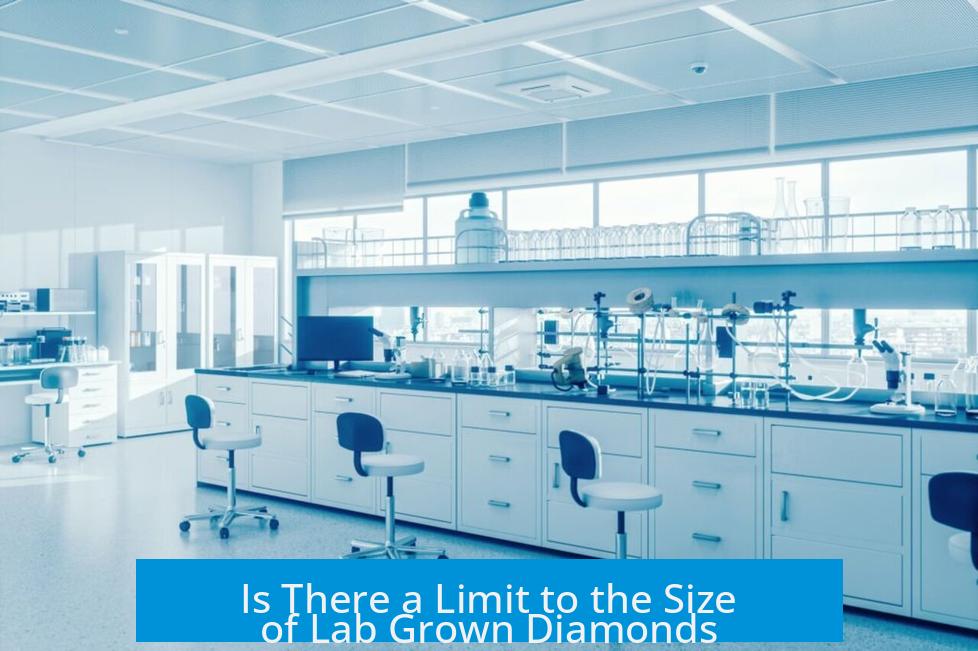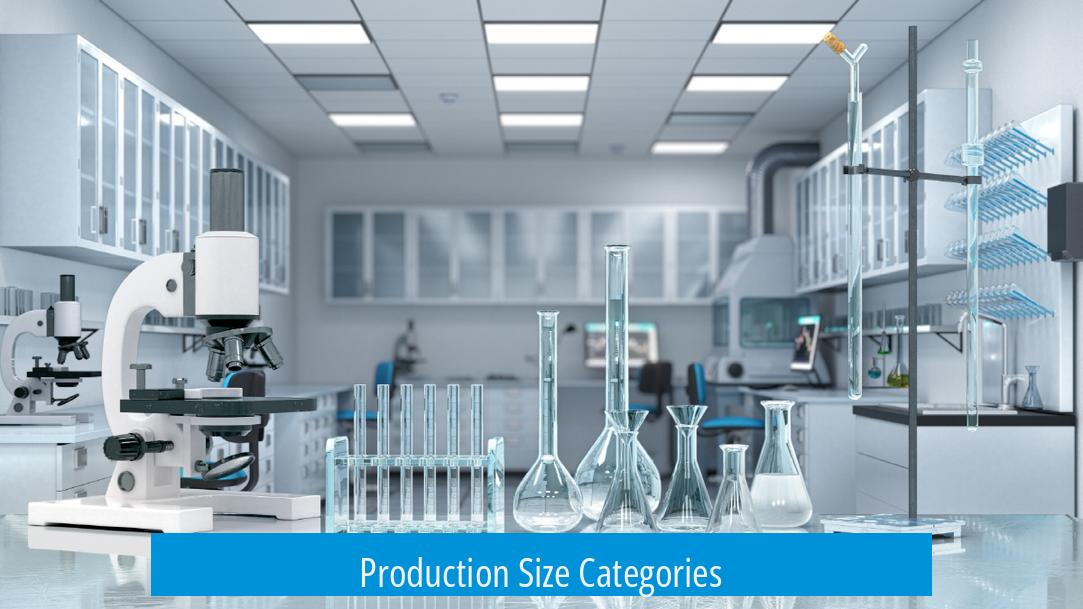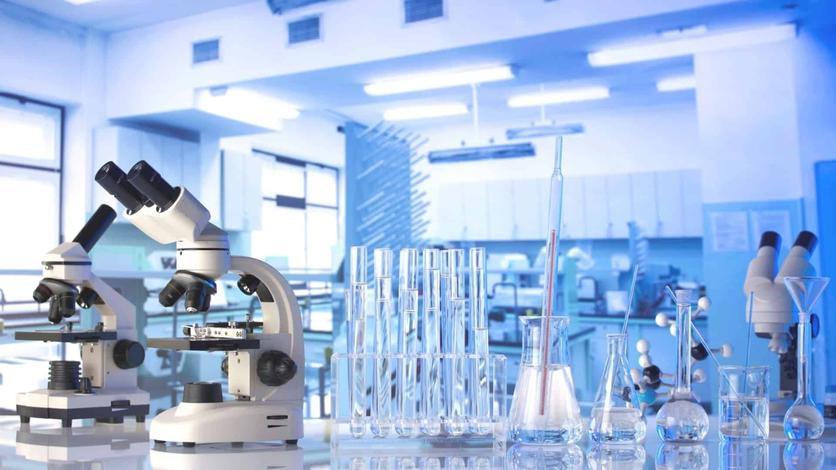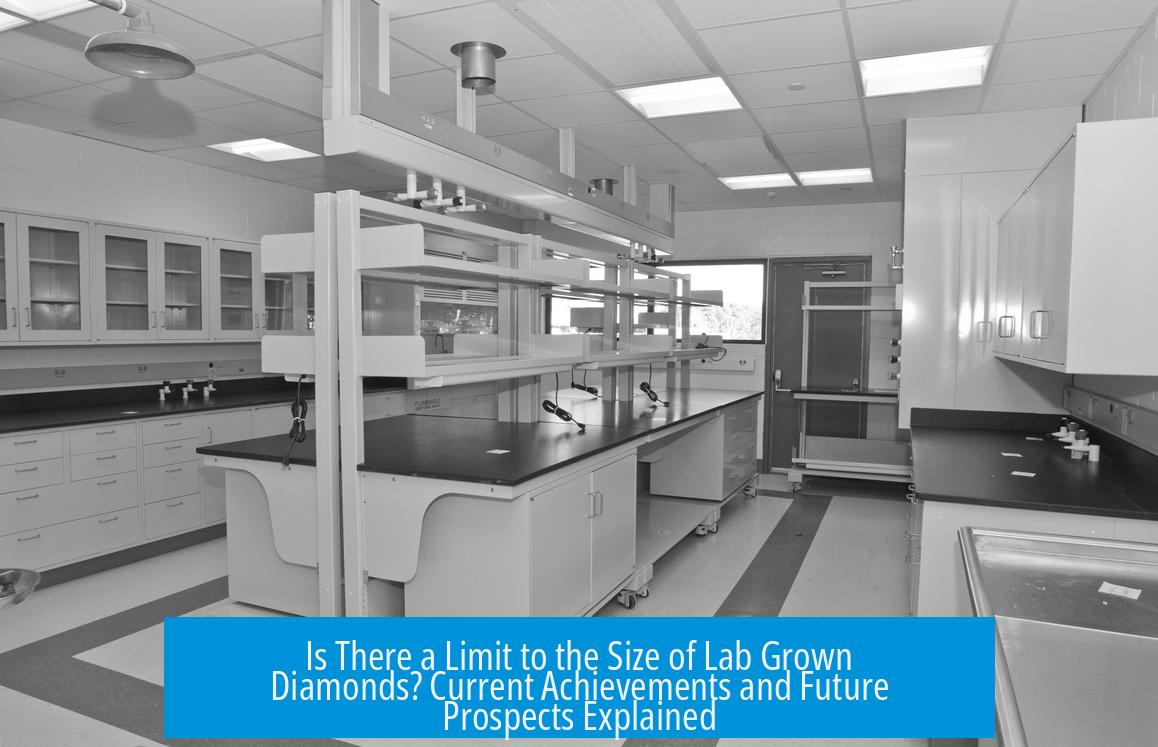Is There a Limit to the Size of Lab Grown Diamonds?
 There is no absolute theoretical limit to the size of lab grown diamonds. However, practical limitations such as technology, time, financial cost, and equipment size define current maximum sizes.
There is no absolute theoretical limit to the size of lab grown diamonds. However, practical limitations such as technology, time, financial cost, and equipment size define current maximum sizes.
Current Size Achievements
The largest lab grown diamond reported to date weighs around 155 carats. Diamonds grown through chemical vapor deposition (CVD) or high-pressure high-temperature (HPHT) methods have reached sizes exceeding 10 carats and occasionally 20 carats for specialty purposes.
Theoretical Perspective

From a scientific standpoint, lab-grown diamonds do not have a fundamental size limit. CVD diamonds grow layer by layer, allowing essentially unlimited carbon-carbon bonding as long as conditions remain stable. HPHT methods face thermodynamic constraints, but these are widely considered not to impose strict size caps.
Technical and Practical Constraints
- Equipment Size: HPHT reactors have physical size limits; making larger reaction chambers is increasingly difficult and expensive.
- Growth Duration: Larger diamonds require longer growth times, increasing the chance of imperfections.
- Financial Factors: Cost rises substantially with size, reducing practical production beyond a few carats.
- Market Demand: Most lab grown diamonds produced commercially range from 0.5 to 3 carats. Larger stones are niche products and custom-made.
Production Size Categories

| Size Range (Carats) | Description |
|---|---|
| 0.5 – 3 | Common market size for jewelry |
| 4 – 6 | Premium size, higher cost and complexity |
| 7+ | Rare, custom order, specialty applications |
Future Prospects
Technological advances continue to push the boundaries of growth size and quality. Large area diamond growth improves prospects in technical applications such as data storage. The idea of diamond “data cubes” able to hold vast information exemplifies upcoming potentials.
Key Takeaways

- No fundamental scientific limit exists for lab-grown diamond size.
- Current largest diamonds reach up to 155 carats, but such sizes are exceptional.
- Practical limits include equipment size, time, cost, and market demand.
- Common commercial diamonds are usually 0.5-3 carats.
- Advances continue to expand feasible sizes and applications.
Is There a Limit to the Size of Lab Grown Diamonds?
Short answer: No, there isn’t a strict, unbreakable limit to the size of lab grown diamonds. You can grow them bigger, but some practical and technical hurdles stand in the way of making monster-sized gems just yet. So, the fascinating field of lab grown diamonds isn’t boxed in by physics or chemistry—it’s more about machinery, money, and time.
Let’s dive into the sparkling details.
Biggest Diamonds So Far: Setting The Benchmark
As of now, the record holder is a dazzling 155-carat lab grown diamond. That’s not exactly a “you need a forklift” size, but it’s still pretty massive for a diamond created in a laboratory. For comparison, natural diamonds can grow to thousands of carats fuss-free, taking millions of years underground. Lab diamonds don’t have the luxury of geological time, so hitting such a big number is impressive.
So, why aren’t there more 155-carat lab diamonds strolling around? Well, there are some constraints.
The Pressing Problem: The HPHT Method’s Size Challenge
One popular technique for lab growing diamonds is High Pressure High Temperature (HPHT). Imagine squeezing carbon atoms together under intense heat and pressure to form a diamond. Cool, right? However, the current tech limits how large the “reaction cell” in these machines can get. Building a ginormous press is insanely tough—physically and financially.
It’s not a fundamental thermodynamic wall, though. Theoretically, those carbon atoms would be happy to bond forever, but the machines just can’t handle super-sized jobs—yet.
Breaking Limits? CVD Growth Holds All the Cards
Chemical Vapor Deposition (CVD) is another lab diamond superstar. It works by layering carbon atoms one by one, almost like making diamond pancakes.
The cool thing about CVD is that it has no theoretical size limit. Since you’re growing diamonds layer by layer, there’s no intrinsic reason to stop at a particular size, at least from a chemistry or physics perspective. Carbon-carbon bonds can keep piling up endlessly, at least in theory.
So why aren’t all diamonds enormous? The main culprits are time and money.
Money Talks: Financial and Practical Hurdles
Growing a super big diamond is a commitment. CVD diamonds usually grow a few millimeters per day. Want a giant 10+ carat stone? Multiply that by days, weeks, and sometimes months. As crystal size goes up, costs do a similar dance—often skyrocketing.
Labs tend to grow diamonds between 0.5 and 3 carats mostly, because those sizes dominate the jewelry market for engagement rings and fine wear. Bigger stones? More niche. Custom orders for 7 carats and beyond do exist but they stretch budgets and patience.
So, What’s Really Limiting Lab Diamond Size?
- Growth time: Longer growth periods risk more imperfections.
- Machine capacity: Press size limits HPHT diamonds, limiting max size.
- Reactor volume for CVD: The size of the chamber caps throughput.
- Financial viability: Bigger stones cost more and take longer, so less common.
- Market demand: Smaller and medium sizes sell better, driving production.
Think of lab diamonds like your favorite video game: there are no level caps in theory, but hardware and wallet limitations apply.
Beyond Beauty: Technical Uses of Big Lab Diamonds
Believe it or not, lab grown diamonds aren’t just about shiny rings and bling. They push frontier boundaries in tech too. Large area diamonds for cutting-edge uses—like in electronics or experimental data storage—are a growing area.
One scientist casually dreams about a diamond data cube holding the entire Library of Congress with room to spare. Sounds like sci-fi, but diamonds have potential well beyond sparklers.
What Does the Future Hold for Giant Lab Diamonds?
Advances in technology are fast. Larger presses, larger reactors, and smarter processes will continue making it easier—and cheaper—to churn out bigger diamonds with better quality.
If you’re dreaming of a huge, flawless lab grown diamond someday, don’t give up hope. The hurdles are mostly practical today, not fundamental. In 10 or 20 years, that 155-carat benchmark might just look like a cute baby step.
Your Takeaway?
- Lab grown diamonds currently reach impressive sizes but aren’t unlimited in practice.
- No fundamental physics block their size growth, especially with the CVD method.
- Practical challenges like machine capability, time consumption, and cost dominate.
- Market demand guides what size diamonds labs prioritize producing.
- Expect bigger, better lab diamonds as tech evolves and budgets grow.
Ultimately, lab grown diamonds are limited by our current technology and willingness to invest time and money—not by the laws of nature. And isn’t that kind of amazing? We’re shaping nature’s hardest gemstone layer by layer, stretching limits as we go.
So next time someone asks, “Is there a size limit to lab grown diamonds?” you can confidently say: “Only the ones humans set—for now.”
Q1: Is there a technical limit to how large a lab grown diamond can be?
For HPHT diamonds, the main limit is the size of the reaction cell, which is hard to scale up. CVD diamonds don’t have a clear technical size limit since they grow layer by layer.
Q2: Why aren’t extremely large lab grown diamonds common?
Large diamonds take more time and cost more to produce. Market demand mostly focuses on sizes between 0.5 and 3 carats, making bigger stones rare and costly.
Q3: What is the biggest lab grown diamond created so far?
The largest reported lab grown diamond weighs around 155 carats, but this is uncommon and usually for specialty purposes.
Q4: Does the growth method affect the maximum size of a lab diamond?
Yes. HPHT diamonds face physical press size limits. CVD diamonds can theoretically grow larger since they build up atom by atom with no inherent size cap.
Q5: Are there financial or practical barriers to very large lab diamonds?
Yes, costs rise and production gets slower as diamond size increases. Also, longer growth times can cause imperfections, limiting practical large-scale production.





Leave a Comment